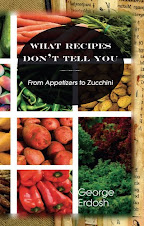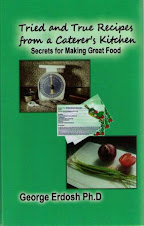Cilantro

Sunday, June 30, 2013
Heat Wave Won't Stop Dedicated Bakers
It’s hovering near 100⁰F outside, yet my oven is on
with a pot of spicy Creole baked beans which is baking in a low oven for two-and-half
hours. We’ll be taking it as a side dish in a few hours to a friend’s barbeque
party. Only the most dedicated cooks would turn the oven on when it’s this hot
(and we don’t have air-conditioning).
I didn’t turn my main oven on in the kitchen
either, would be crazy to heat the house up. Yet yesterday I baked a
zucchini-cream cheese cake and a few days before that our regular two loaves of
bread.
My secret weapon is a portable convection oven
sitting on a shelf in the garage. As long as the weather is warm, my convection
oven is running nearly daily. In fact, should the garage get too hot, I need to
carry it outside as too high temperatures seem to interfere with the action of
the thermostat. This oven is the size of a large microwave, big enough for a
small turkey, and weighs perhaps twenty pound, easy to carry around.
Occasionally people ask me the difference between
a conventional and convection oven. This is strange as many of the newer
household ovens have a convection option. The answer is very simple: convection
ovens have a fan to circulate the air around for even heat, faster baking. Now
many of the inexpensive toaster ovens brag about being a convection oven but
that’s not exactly true. The feeble air movement with a pathetic little fan
hardly does anything else than creating noise.
Real convections have powerful enough fans to be
effective besides making fan noises. You need to reduce oven temperature called
for in the recipe by twenty-five degrees F and baking or roasting time is
likely to be at least ten percent shorter. Commercial bakeries and kitchens
commonly have large highly efficient convection ovens in addition to their
conventional ones.
Here is what I baked: Quiche Salinas or marinated artichoke-sharp cheddar cheese quiche. Little crooked (pastry was a bit soft and the weather hot) but it tasted good for our lunch company.
The only thing you cannot do in the convection
oven is bake cakes and tortes which are leavened only by egg or egg white foam.
The slight vibration of the fan is enough to collapse the weak structure of the
cake before it’s fully baked.
If you are a dedicated baker, hot weather will not
stop you. Most everyone can find a place for these relatively small
appliances—if not in a garage, any backyard or balcony will work. Good ones are
not inexpensive but cheap ones are not very good.
Monday, June 10, 2013
COOKBOOKS -- How I Rate Them as Reviewer
As a cookbook reviewer, I occasionally come across
some awesome cookbooks.
Professional book reviewers follow Amazon’s system
giving each book a star ranging from one to five. I review close to hundred
books a year most of which are cookbooks. I regularly receive these books from
three book review magazines. Cookbooks (or food-related books) given five stars
are truly exceptional and not common. Really bad books surface in the mail too but
they are not common either. Our criterion of giving one star to a book is: “Probably only going to be read and enjoyed by the author's
mother.”
I am often asked by
friends and acquaintances how I arrive at the rating of a cookbook.
First, the recipe
writing: it must be absolutely clear, unambiguous, ingredient amounts also
clear and in easily measurable amounts in a home cook’s kitchen; step-by-step
instructions in logical order; ingredients listed according to cooking steps
used. I check to make sure no ingredients are missing either from the list or
from the directions. Are most ingredients readily available and known to a home
cook? Are there professional jargon used a cook needs to look up in a
dictionary?
Then comes the layout
of the recipes. Good cookbook authors insist that the recipes are laid out to
the convenience of the cook not to the book designers. If you need to flip
pages back and forth to follow a recipe, the layout is poor. Illustrations
related to a recipe should be close to the recipe itself.
Recipe headnotes
should be interesting to read and informative to the cook. This also applies to
the sidebars, tables, and charts. Good food writing rates high in my reviews
but endless personal stories and history can be boring that readers will only
read once (if at all). Also illustrations: some authors include many, many
personal photos from babyhood on which I consider fillers. The quality of food
photography may be amateurish or professional, as well as sketches and
step-by-step thumbnail photos.
Index is extremely
important. Having poor index is very frustrating to a cook when attempting to
find a previously prepared recipe. Index needs to be thoroughly
cross-referenced to be useful. (Roasted Tuscan Eggplant should be listed under
eggplant and Tuscan but not under Roasted.)
A good cookbook also
have extras: perhaps something about unusual ingredients, about the cooking
techniques used, history and origin of the recipe and so on.
Using a very good
professional cookbook editor (not just any book editor) and a professional
indexer don’t guarantee a good cookbook but it’s likely to lead the way to five
stars.
Sunday, June 9, 2013
Scrambled Eggs the Chinese Way
Some year ago I visited a good childhood friend in
Toronto, staying overnight for a couple of days. My friend delivered bread from
a bakery so his work started well before dawn—in fact even before some folks
hit the bed for the night. His wife was a late riser and I would’ve gladly fixed
my own breakfast (even though I dislike trying to find things in someone else’s
kitchen). But their ten-year old daughter, Jenny insisted that she will scramble
two eggs for me.
She put a sauté pan on high heat while she lightly
beat the eggs, adding salt and pepper and some chopped scallions. Wooden spoon in
one hand and serving plate ready, she swirled a teaspoon of vegetable oil in
the smoking hot pan then she quickly dumped the eggs into the hot oil and
within fifteen or twenty seconds the eggs were done.
As a food expert I was dismayed, knowing that only
slow heat can produce good, creamy-soft scrambled eggs but, not trying to hurt
her feelings, I accepted my fate with resignation. I sat down to have the best
scrambled eggs anyone ever served me. What happened?
Jenny actually stir-fried the eggs so quickly that
they didn’t lose their natural moisture. Ordinarily the tight spring-like protein
molecules of the eggs unfold on cooking, and the heat drives off their moisture,
turning the scrambled eggs dry. Yet Jenny’s cooking process was so fast that the
proteins retained their moisture. The eggs coagulated in the pan and remained
soft and flavorful thanks to the high heat.
Try this simple method next time you have
scrambled eggs in a meal plan. Just make sure everything is ready. You cannot
leave the eggs in the hot pan even ten seconds too long.
Subscribe to:
Comments (Atom)





 Stumble It!
Stumble It!










